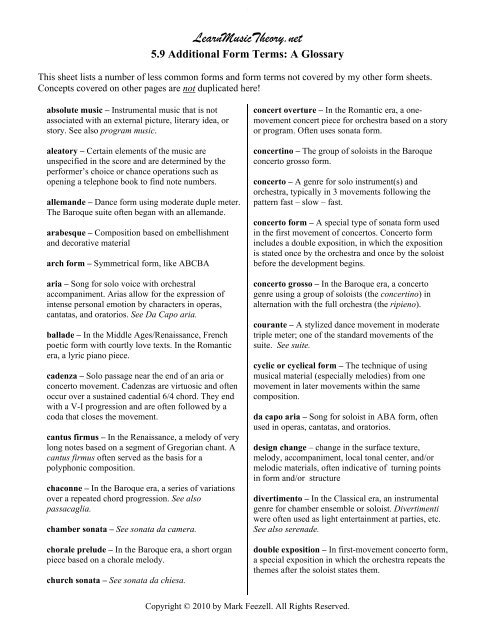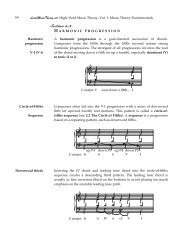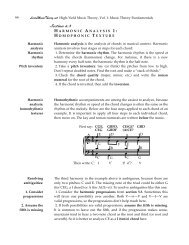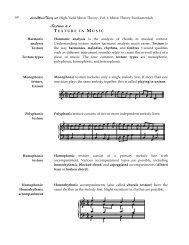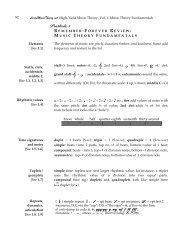Form Terms Glossary: Free PDF Printable - Music Theory
Form Terms Glossary: Free PDF Printable - Music Theory
Form Terms Glossary: Free PDF Printable - Music Theory
Create successful ePaper yourself
Turn your PDF publications into a flip-book with our unique Google optimized e-Paper software.
.Learn<strong>Music</strong><strong>Theory</strong>.net5.9 Additional <strong>Form</strong> <strong>Terms</strong>: A <strong>Glossary</strong>This sheet lists a number of less common forms and form terms not covered by my other form sheets.Concepts covered on other pages are not duplicated here!absolute music – Instrumental music that is notassociated with an external picture, literary idea, orstory. See also program music.aleatory – Certain elements of the music areunspecified in the score and are determined by theperformer’s choice or chance operations such asopening a telephone book to find note numbers.allemande – Dance form using moderate duple meter.The Baroque suite often began with an allemande.arabesque – Composition based on embellishmentand decorative materialarch form – Symmetrical form, like ABCBAaria – Song for solo voice with orchestralaccompaniment. Arias allow for the expression ofintense personal emotion by characters in operas,cantatas, and oratorios. See Da Capo aria.ballade – In the Middle Ages/Renaissance, Frenchpoetic form with courtly love texts. In the Romanticera, a lyric piano piece.cadenza – Solo passage near the end of an aria orconcerto movement. Cadenzas are virtuosic and oftenoccur over a sustained cadential 6/4 chord. They endwith a V-I progression and are often followed by acoda that closes the movement.cantus firmus – In the Renaissance, a melody of verylong notes based on a segment of Gregorian chant. Acantus firmus often served as the basis for apolyphonic composition.chaconne – In the Baroque era, a series of variationsover a repeated chord progression. See alsopassacaglia.chamber sonata – See sonata da camera.chorale prelude – In the Baroque era, a short organpiece based on a chorale melody.church sonata – See sonata da chiesa.concert overture – In the Romantic era, a onemovementconcert piece for orchestra based on a storyor program. Often uses sonata form.concertino – The group of soloists in the Baroqueconcerto grosso form.concerto – A genre for solo instrument(s) andorchestra, typically in 3 movements following thepattern fast – slow – fast.concerto form – A special type of sonata form usedin the first movement of concertos. Concerto formincludes a double exposition, in which the expositionis stated once by the orchestra and once by the soloistbefore the development begins.concerto grosso – In the Baroque era, a concertogenre using a group of soloists (the concertino) inalternation with the full orchestra (the ripieno).courante – A stylized dance movement in moderatetriple meter; one of the standard movements of thesuite. See suite.cyclic or cyclical form – The technique of usingmusical material (especially melodies) from onemovement in later movements within the samecomposition.da capo aria – Song for soloist in ABA form, oftenused in operas, cantatas, and oratorios.design change – change in the surface texture,melody, accompaniment, local tonal center, and/ormelodic materials, often indicative of turning pointsin form and/or structuredivertimento – In the Classical era, an instrumentalgenre for chamber ensemble or soloist. Divertimentiwere often used as light entertainment at parties, etc.See also serenade.double exposition – In first-movement concerto form,a special exposition in which the orchestra repeats thethemes after the soloist states them.Copyright © 2010 by Mark Feezell. All Rights Reserved.
5.9 Additional <strong>Form</strong> <strong>Terms</strong>: A <strong>Glossary</strong>, cont.doubles – The name for each variation in a Frenchkeyboard suite. See ordres.elision – An overlap in which the cadence chordterminating one phrase becomes the first chord of thenext phrase.étude – Study that focuses on a technical problem fora particular instrument.fantasia – Extended instrumental piece (oftenBaroque) intended to sound like an improvisation.fixed forms – A set of forms from medieval Francebased on fixed poetic structures. The fixed formsinclude the ballade, the rondeau, and the virelai.French overture – In the Baroque era, anintroductory movement for an opera, ballet, or suite,having a slow introduction followed by an allegro.gavotte – In the Baroque era, stylized dance type induple meter having a pastoral character.gigue – An English Baroque dance in fast compoundmeter. The gigue was a standard movement in theBaroque suite.ground bass – A melody that repeats in the bassthroughout an entire movement. See passacaglia.idée fixe – “ee-DAY feeks” A term coined by Berliozand especially relevant to his Symphonie fantastique.An idée fixe returns in various movements and unifiesa work. See cyclic form.incidental music – <strong>Music</strong> intended to be performedwith a play.interlude – <strong>Music</strong> composed to stand betweenprimary sections of a composition, opera, or play.intermezzo – In the 18 th -century, a comic interludebetween the acts of an opera seria. In the Romanticera, a short, lyrical composition, usually for piano.isorhythmic motet – In the Medieval and earlyRenaissance eras, a motet using isorhythm. Isorhythmis the technique of repeating a pitch sequence andrhythm sequence of different lengths throughout thepiece. The rhythm sequence is called the talea, and thepitch sequence is called the color.Italian overture – In the Baroque era, an overturewith the sectional pattern fast – slow – fast.Leitmotif – The basic recurring melody associatedwith a person, object, or idea throughout a Wagnerianopera.Lied – In the 19 th century, a solo art song with piano.(Lied is German for “song.”)madrigal – In the Renaissance, a secular vocalcomposition with or without accompaniment andusing a short love text. Madrigals were most popularin Italy and England.march – A movement or piece with accented duplemeter, repetitive rhythms, and a generally militarycharacter.mazurka – Folk dance of Poland in triple meter.Chopin wrote a number of mazurkas for piano.minimalist music – Contemporary style usingextensive repetition of simple melodic or rhythmicpatterns.moment form – <strong>Form</strong> in which each instant of thecomposition stands on its own without any formalconnection to the other sections of the piece.monothematic – Composition or movement usingone theme.nocturne – A piece designed to evoke the peacefultranquility of night. Chopin wrote many for piano.open form – Contemporary approach to form inwhich the performer or chance operations (such aslooking up numbers in a phone book) determine theorder of the sections in the form.oratorio – In the Baroque era, a dramatic compositionfor solo voices, chorus, and orchestra, intended to beperformed in a concert setting (without scenery andcostumes). Oratorios typically used religious or otherserious texts.ordre – See suite. Couperin coined this term and itwas later used for some French suites.ostinato – A short repeated musical pattern. Ostinatimay be melodic, rhythmic, or harmonic.Copyright © 2010 by Mark Feezell. All Rights Reserved.
5.9 Additional <strong>Form</strong> <strong>Terms</strong>: A <strong>Glossary</strong>, cont.partita – See suite.passacaglia – In the Baroque era, a piece in slowtriple meter with a ground bass.phasing – Contemporary technique in whichperformers gradually move “out of phase” then back“in sync” as they perform an ostinato together inunision and one performer speeds up slightly.program music – Instrumental music that hasassociations with images, literary concepts, or a story.See also absolute music.recitative – Solo vocal movement that attempts torecreate the rhythms and inflections of ordinaryspeech; in operas, canatatas, and oratorios.ripieno – In a Baroque concerto grosso, the largeensemble that alternates with the concertino.ritornello – In a Baroque concerto, the tutti passagethat recurs between solo sections.sarabande – In the Baroque era, a Spanish stylizeddance type in triple meter. The sarabande was one ofthe four standard movements of the German suite.See suite.serenade – In the Classical era, an instrumental genreperformed at evening social functions. Closely relatedto the divertimento and cassation.Perhaps the most famous is Mozart’s Eine KleineNachtmusik.suite – A multimovement grouping of contrastingdance movements, generally sharing a single key.Also called partita and ordre. Many Baroque suitesconsist of an Allemende, Courante, Sarabande, andGigue. This combination was commonly called a“German suite” form. French suites were lesspredictable.symphonic poem – In the Romantic era, a singlemovementcomposition for orchestra with a program(see program music). Also tone poem. Franz Liszt(1850’s) and Richard Strauss (early twentieth century)are important composers of tone poems.symphony – Orchestral work in 3 or 4 movements.Typically, the first movement is in sonata form, thesecond is a slow movement, the third is a minuet andtrio or scherzo and trio, and the fourth is a rondo orsonata form. Many variations of this basic templateexist.trio sonata – In the Baroque era, a chamber sonatawith two melody lines and a basso continuo bass line.The basso continuo bass line would have beenrealized by a bass instrument (such as cello) and akeyboard player, yielding a total of 4 performers.variation – The repetition of musical materials withalteration, but such that the source materials are stillrecognizable.vocalise – A vocal melody without text.waltz – Triple meter dance type. In the Romantic era,a stylized dance type often used for piano pieces.sonata da camera – In the Baroque era, aninstrumental suite of stylized dances. Also calledchamber sonata.sonata da chiesa – In the Baroque era, aninstrumental work for church performance. Usuallyhad 4 movements: slow—fast—slow—fast. Alsocalled church sonata.song cycle – Grouping of songs that share musicalelements or textual relationships and are oftenintended to function as a single composition.strophic form – Vocal form in which the same musicis repeated with different stanzas (or strophes) of text.Copyright © 2010 by Mark Feezell. All Rights Reserved.


